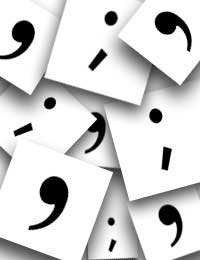A Look at Commas and Semi Colons

Commas and semi-colons are common place in English writing. If a piece of text you were reading had no commas or semi-colons, you would struggle to understand what you were reading. There are however, certain rules and regulations where commas and semi-colons are concerned; some of which, we will go through here.
The Purpose Of The Comma
Commas are used inside of sentences, and they are basically used as a pause in the text. Commas have no actual meaning; however, they help add structure to a sentence, therefore add meaning to the sentence.Using Commas In Lists
You would use a comma when creating a list or a series of events, or objects. When you come to the end of the list and the last two objects in it, a comma doesn’t normally need to separate them. Instead, you would add the word ‘and’ between them. But, if the two final items are long, a comma may be beneficial.- I need to buy tea, coffee, toilet paper, sugar, eggs, milk, butter and salt.
- My favourite animals are lions, tigers, cats, dogs, elephants and hyenas.
- Jackson wore his new cap, black jeans, white trainers, and his brand new black and white shirt.
Using Commas With Adjectives
When you are creating a list of adjectives or even adverbs, you will need to use commas to separate them.- I like the antique, brown, wooden chair.
- I think I am going to buy the green, new, open-top car.
- She crept silently, stealthily and quickly.
If only using two adjectives you could use a comma where you might otherwise put ‘and’.
- I loved it because it was a short, simple piece.
- My dog is a big, black one.
Commas And Numbers
In English, numbers after 999 are separated using commas. Commas separate the numbers, whereas periods (full stops) separate the decimals.- 1,000
- 1,567
- 1,399,500
Using Commas With Names And Addresses
Generally speaking, commas are used when writing addresses, titles following a name and some dates.- 45 England Road, England Town, England
- Bolton, England
- On the 17th November, 1999...
- Maureen Lang, Stylist to the stars
Commas And Direct Speech
Direct speech is different to reported speech. When using reported speech, you won’t need to use a comma. Direct speech includes phrase such as “he said”, “she said” and so on.- Direct Speech – “I never want to see you again, he said.”
- Reported Speech – “He told her he never wanted to see her again.”
Commas And Introductions
When using an introductory element to your writing, you will need to add a comma before adding your next point.- As the year came swiftly to an end, she realised how quick time flies.
- During the speech at the university, he fell asleep.
Commas are usually used when combining two sentences into one. For shorter, well balanced sentences, using a comma is optional. However, it may bring a little more structure to your writing. Adjoining words such as "and, but, however and so", usually require a comma in front of them.
Semi-colons
Semi-colons are thought of as ‘soft’ full stops. They join two related sentences together. Using semi-colons instead of full stops can allow the reader to see that the two ideas are connected in meaning.- All I can say is you did your best; now, we have to wait for the results.
- Richard prefers tea; Sarah prefers coffee.
- Samuel wants to stay in; Isabelle wants to go out.
Commas and semi-colons are an essential part of the English language. Without them, we wouldn’t be able to read, write or speak fluently. There are a lot of people who struggle with the rules associated with commas and semi-colons. With a little practice, everyone could be putting commas and semi-colons in the right place.


Re: Why English Grammar Is Important
There are a certain parts that werent.... Or There are certain parts that werent...
Re: Understanding Intonation and Stress in Speech
How much for the intonation e-book? Best regards, Lily
Re: English Language: Silent Letters
@Deb - according to the Cambridge Dictionary, it should be pronounced 'wenz.de', which doesn't sound right - I think…
Re: English Language: Silent Letters
I have never known the "d" in Wednesday to not be pronounced - it should be Wed-nes-day - which is from the Germanic Wodan's…
Re: Using English Verbs, Adverbs and Adjectives
i need to know all the adjectives and verbs for my GCSE exam omg i am sick of exams now they are anoying me
Re: Using English Idioms
I found the contents very useful and relevant to my classroom transations.
Re: What You Will Need to Learn English
i love reading your article it help me to understand how important for me to reading english.. i want to learn english…
Re: How to Write Paragraphs
As a teacher teaching English I find your website helpful. Cheers
Re: Ten Tips to Help You Learn English as a Second Language
The biggest mistake Spanish students make is trying to translate word for word. For example;…
Re: English Language: Silent Letters
A longtime since ive been in grammer school.I will be 80 years old my next birthday, This is a very enlightening ,and helpful…